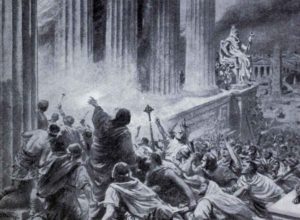 A week or two back, I discussed a review of The Darkening Age: The Christian Destruction of the Classical World by Catherine Nixey, a book out in the UK, but not due for release in the US until next year. Back in the old country over the weekend, I took the opportunity to buy a copy, and it’s as good as the review suggested it might be. I read it in two sittings.
A week or two back, I discussed a review of The Darkening Age: The Christian Destruction of the Classical World by Catherine Nixey, a book out in the UK, but not due for release in the US until next year. Back in the old country over the weekend, I took the opportunity to buy a copy, and it’s as good as the review suggested it might be. I read it in two sittings.
Much of the focus of my last post was on the fixation of the early Christians with suffering, a fixation that lingers on in the shape of a morbid belief in the virtue of suffering, a belief that manifests itself in, among other horrors, the opposition of many clerics, as cruel as it is saccharine, to assisted suicide.
But Nixey’s book is, above all, fascinating as an examination of proto-totalitarianism. Nixey, no Dawkins, is not so much concerned with the existence of God or the divinity of Jesus as she is with the behavior of the latter’s followers in late antiquity, whether it’s the iconoclastic fervor that led them to destroy so many of the great works of classical art and architecture, or the creation of a system that dictated so thoroughly what men read (book burnings were a regular feature of these years), how they worshiped and what they thought. The Judeo-Christian God was a jealous god and, unlike the expansive and eclectic collection of deities of the Roman Empire, had no room for any rivals or, for that matter, their followers. There was a sting in monotheism’s tale. To the modern reader, Nixey’s accounts of persecution in the name of the Christian God foreshadow both the furies unleashed on behalf of His Islamic alter-ego and, for that matter, Communism’s supposedly secular millenarians.
The Church, wrote Augustine, “persecutes in the spirit of love”, and, over a millennium and a half before Communism’s slaughtered one hundred million, he claimed that “where there is terror, there is salvation.”
Whatever or whoever had been born in Bethlehem, a rough beast was on the march—and, while its shape may shift, it marches on today.
